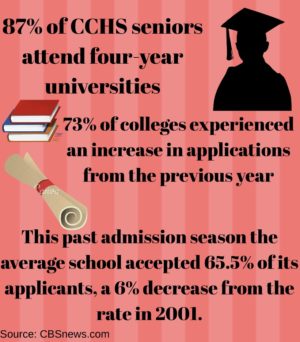Rejection awaits for best, brightest, and brainy
April 26, 2018
Mater Dei Catholic High School alumna Sophie Baldarrema ’15, who maintained a 4.5 GPA in high school, served as a club president, and competed on the school’s swim team, applied for a spot at Columbia University. Despite a perfect SAT score and stellar letters of recommendation, Baldarrema was declined.
Her dreams were crushed.
“It was one of the hardest moments I’ve had to deal with, mainly because for four years I dedicated so much time and effort, and still got rejected,” Baldarrema, now a junior at USC, said. “Even though I love the university where I ended up, I know what millions of students feel like, especially after a year like the one we just saw for college admissions.”
Baldarrema’s story is not unique.
This past college acceptance season has witnessed a spike in increased competition for limited seats at U.S. colleges and universities, resulting in increased rejections notices being received by otherwise highly qualified applicants.
For example, The Daily Pennsylvanian reports that in 2017, the acceptance rate for Columbia’s class of 2021 was at 5.5 percent as compared to the 6.9 percent for the class of 2015. Moreover, Stanford University’s acceptance rate was a 15.5 percent in the year 2001, but today Stanford’s acceptance rate is at 4.7 percent.
Stanford’s decrease in acceptance rate exists as an accurate model of other Ivy and Division I colleges throughout the U.S.
In regards to college admissions, 2017 is proof that with each year that passes, admissions become more competitive, causing millions of U.S. students excessive stress and disillusionment.
Millions of students dedicate themselves and diligently strive to attain the perfect GPA, while also balancing extracurriculars during a four-year period, only to be rejected for a spot at elite universities.
Every year approximately 3.3 million students graduate high school, and about 66 percent of them enroll immediately in college. Despite sounding fairly reasonable, some of the most elite universities reject up to 95 percent of the best, brightest, and brainy students, according to National Center for Education Statistics.
And each year gaining acceptance gets even more difficult.
Students who applied to colleges in 2017 for a place in Fall of 2018 realized the odds were not in their favor as last year was the most selective year students have endured so far regarding college admissions.
Mrs. Jessica Saenz-Gonzalez, the owner of the San Diego Learning Center, offered SAT and ACT prep to students for the past decade, and she noticed how selective universities have become.
“Over the years, I have definitely seen colleges become more selective and way more competitive,” Mrs. Saenz-Gonzalez said. “Sometimes it doesn’t matter how smart you are, or how many clubs you are in. Sometimes it just comes down to what the universities need to keep the diversity balanced.”
A huge factor regarding the difficulty and competitiveness for college admission is based on what the universities need.
For example, one year institutions of higher learning might need more females than males to adjust their gender ratios. Or sometimes, colleges and universities might need to increase their international numbers, giving foreign students priority that year as compared to native students.
“It really depends on what the university needs,” Mrs. Saenz-Gonzalez said.
The problem is much more complex because it features two unique sides.
On the positive side, double the amount of U.S. students want to pursue higher education. However, because of this desire, more students apply each year, thus adding more pressure and competition.
“I think the main difference I see between students who apply to college today, and what I went through when I applied to college, is the number of students who apply,” CCHS college counselor Ms. Kristen Micho said. “Every year the number of applicants grow, but the number of seats available for most colleges aren’t keeping up with this growth. Colleges want to see more than GPA and test scores.
“Along with the rigor of their courses, colleges want to see how a student is challenging themselves in order to reach their best potential.”
When the admission officers admit students, they evaluate GPA, test scores, and course rigor. In the end, colleges want to see the degree to which a student challenges himself or herself to reach his or her potential.
Despite sounding extremely daunting, competition among colleges and universities always has existed. However, with more than 4,000 colleges and universities available to students, more options exist other than their dream schools.
“Even though I didn’t end up getting into my dream school, I’m so happy to be at USC,” Balderrema said. “It ended up being the perfect fit for me.”






















































